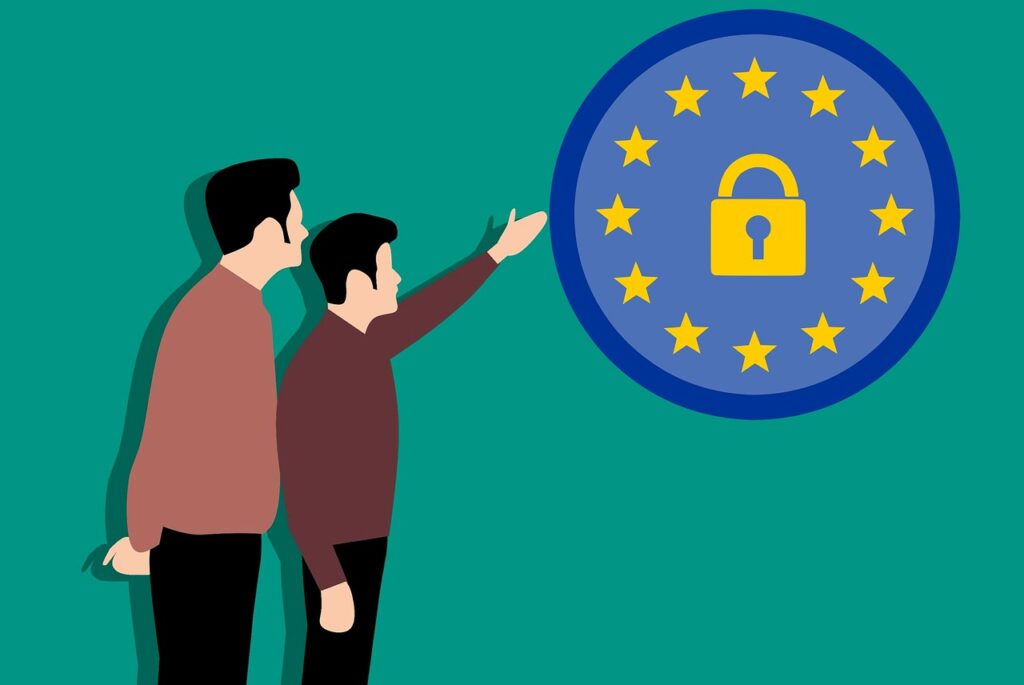The GDPR or General Data Protection Regulation is an EU regulation that protects all European citizens’ online privacy. It states how data is collected and used when your website visitors interact with your site and helps protect their data.
All business websites must be GDPR compliant and ensure all users are aware of the data collected.
The GDPR act affects all websites whether your business is based in Europe or not since you are likely to get users from the EU region interacting with your site.
So, take the following steps to ensure you are GDPR compliant and avoid lawsuits.
SUBSCRIBE TO INCOME PATROL
Get updates on the latest posts and more from Income Patrol straight to your inbox.
UNDERSTAND GDPR COMPLIANCE
The best way to understand the GDPR act and ensure your site is compliant with it is to read more about it. You first need to know what it is, the requirements, the rules, and how it affects your business.
The main purpose of the act is to protect user data and prevent data misuse and exploitation.
The GDPR gives users complete control over their data and states that all your website visitors have the right to know the type of information you collect and track. It doesn’t forbid website owners to collect or use user data. It simply requires you to clearly state what sort of data you collect, ensure users understand the information you monitor and also give site visitors complete control over the type of data you collect. For example, they should be able to choose whether or not to allow you to collect, track, or use their data.
The goal is to ensure you get user consent to collect and use their data and avoid doing so without notifying your website visitors.
Here are some of the important rules that the GDPR act includes;
• All businesses must inform users how they track, process, and store their data.
• It should be easy for your site visitors to accept or decline your request.
• Individuals have the right to ask for limited use of their data at any time.
• Users have the right to request a copy of the data you collect on them.
• All businesses must provide a way for user data to be permanently erased. In case users require it.
• Individuals have the right to revise, correct, or remove any personal data websites have on them whenever they need to.
• All serious data breaches must be reported within 72 hours.
• Businesses will be fined 4% of the annual turnover for violating the GDPR act.
The GDPR act states how businesses should collect personal data and process it. Personal data includes user names, addresses, biometric data, ID numbers, health data, generic data, financial information, demographic information, RFID tags, and so on.
Data processing includes how data is to be collected, organized, used, structured, stored, and erased.
Read and understand the act to ensure you follow the given guidelines and avoid legal issues.
Now that you have a basic picture of the GDPR act, follow the next steps to ensure your website is GDPR compliant.
RUN A CUSTOMER INFORMATION AUDIT
Run a customer information audit to understand the type of user data you collect. Know the type of personal data you collect, track, use, and store to ensure you adhere to the given guidelines.
Track and identify all the data you are holding. Find out where and how it was collected and shared. Determine whether or not the data was used for the purpose for which it was collected.
Identify all the data collection points on your website and review them. Know the type of information you collect via your registration forms, analytics apps, checkout page, and so on.
Document all the personal data you have and track the security measures implemented to find out how the information you’re holding is protected.
Get rid of unnecessary data or the type of data that you no longer need or use to easily manage the data you have, effectively run audits, and easily stay up-to-date with the GDPR updates. Limit the data you collect and only ask for the information you need.
If you are using form plugins to gather user data, user information can be stored automatically in your database. So, make sure you delete the information that’s collected without the user’s consent or select the ‘Do not store user data’ option on the plugin configuration settings.
Run DPIA or Data Protection Impact Assessments frequently to identify potential data breaches, ensure data security, and determine whether or not your business is GDPR compliant.
Your Data Protection Impact Assessment should help you determine whether or not you are adhering to the GDPR data processing requirements or guidelines. So, that you can make the necessary changes.
REVIEW YOUR PRIVACY POLICIES
Every website needs a privacy policy that clearly states what sort of information you track, gather, or use. Your policy must be easy for users to understand and make it easy for them to accept or disagree with the terms and conditions. They must easily understand what they’re agreeing to and willingly give you permission to collect and process their data.
So, go through your privacy policy and find out if it’s GDPR compliant. If it’s not, make the necessary updates. State what sort of information you collect, why you collect it, how you will use it, who will have access to it, where you will store it, how long you will keep it, and how users can access it, in case they need to.
Send out your privacy notice to your customers, if you’ve already collected their data or are using it in any way.
Allow customers to easily agree or disagree with the terms of your privacy policy.
Always follow the GDPR act, update your privacy policy frequently, and notify your customers about the applied changes.
If you don’t have a privacy policy, add one on your website. Read and understand what the GDPR act requires to ensure you stick to the rules and keep your website compliant at all times.
Make sure your policy clearly states that you collect and process user data. Detail data collection practices, data privacy rules, and cookie usage. Use simple and plain language to ensure users understand your policy.
PRIORITIZE SECURITY
Protect customer information and prioritize security to avoid data breaches. As a business owner, it is your responsibility to ensure user data is safe from unauthorized access. Therefore, implement the best security standards on your business website and secure user data.
Encrypt data and make sure users send and receive information through secure channels. If you have an e-commerce store, create a secure payment page. Doing this helps you protect customer information and ensure it doesn’t fall into the wrong hands.
Use secure email to communicate with clients. Use HTTPS instead of HTTP on your website URL to keep user data encrypted and make it easy for visitors to trust your site and in turn convert them into buyers.
Secure your business website and update it regularly. That means if you are using any templates, plugins, or any other 3rd party software to build your website, constantly check for updates and keep them updated to the latest version. Doing this helps you protect your site from vulnerabilities and is a great way to prevent unauthorized access.
If your site is built with WordPress, keep it updated to the latest version.
WordPress now makes it easy for you to keep your website GDPR compliant. WordPress version 4.9.6 and higher have built-in privacy settings that make it easy for you to keep your site GDPR compliant.
The latest WordPress version now includes the privacy policy generator, opt-ins for commenting, and data export features.
The privacy policy generator gives you access to a premade privacy template that makes it easy for you to create a privacy policy for your site. The template allows you to create a page that informs users about the kind of data you collect, track, use, and store. It also outlines how the information you gather is processed and shared. Simply edit the template and add your content.
Access the policy generator by going to ‘Settings and Privacy’ on your WordPress admin dashboard.
The opt-in feature provides a check box on the comments section of your web pages that users can click on if they want to give you permission to collect, store, and use their data.
When the user checks the box, their information will be stored and remembered so that they won’t have to retype their names and emails.
The data export and erase features allow you to export user information or erase it from your database permanently.
Go to ‘Tools’ on your dashboard to access the data export and erase features.
Many WordPress plugins collect and use user data. Some of them comply with GDPR while others don’t. Therefore, make sure you review every plugin you want to install and only use GDPR compliant ones. Find out how each plugin handles user information. If you choose to use the plugin, state how you collect, process, store and share user information.
OBTAIN USER PERMISSION
Obtain user permission to access, track, use, or store their data. Add a clear notification on your site to notify users that your website collects cookies. For example, their data, site preferences, and browsing information.
Add a clear ‘Accept’ or ‘Decline’ button to allow users to accept or decline your request. That way, you will get clear consent from your site visitors to place and track cookies.
If the user doesn’t give you permission to collect and track their data, don’t place cookies on their browser.
Note: Users should still be able to browse your site even if they don’t permit you to collect, share, or store their data.
Add a popup on your homepage to notify visitors that your website collects cookies and make it easy for them to consent to or decline cookie use.
Users protected by the GDPR act have a right to ask for a copy of the kind of data you collect on them at any time. Therefore, prepare for data requests and give users an electronic copy of the information you collect.
The GDPR act states that you have to deliver the requested data within 30 days.
PLAN FOR A DATA BREACH
Plan for a data breach because it can happen at any time despite how secure your site is. That is because hackers are always looking for ways to stay one step ahead of the latest technology and exploit user data.
Come up with a plan that helps you deal with security breaches. Clearly state what action will be taken when a breach is detected, how you are going to stop the breach, and what steps you’ll take to communicate security breaches to regulators, and the affected individuals or organizations.
Your plan should also state how you’ll detect potential breaches and avoid them.
Note: You have to notify regulators and the affected individuals of the security breach within 72 hours.
Customers or users who permit you to collect their data may require you to delete their information from your servers. Therefore, know how to delete customer data when they ask you.
Make sure your privacy policy clearly outlines the steps you’ll take when users ask you to permanently erase their data. Read the GDPR act to understand when you are required to delete user data and under what circumstances.
Make sure you have processes that allow you to easily access and delete user data.
Customers may require you to prove that their personal information has been erased from your servers. Therefore, you must be able to show them that their information has been successfully deleted.
Keeping up with the GDPR updates, updating your privacy policy, and notifying users or customers about the recent changes can be demanding. Therefore, use GDPR compliance plugins to save time, ensure users receive updates when they should, and make things easier for yourself.
A GDPR compliance plugin helps you create notifications easily and notify users about any recent updates.
Another option is to use an email broadcast to inform customers or users about privacy policy updates or data breaches.
SEEK LEGAL ADVICE
Lastly, seek legal advice. Work with a lawyer who understands GDPR and has experience in it.
The legal advisor will help you understand GDPR and comply with it.
Work with reputable law firms or search for well-known GDPR and Data Protection lawyers online.
You can also work with consultants that have experience in the area. Approach people who have helped and are helping businesses with data protection. The consultant will help you determine whether your website is GDPR compliant or not. He or she will also help you understand GDPR and ensure your website is compliant.
Another option is to hire a DPO or Data Protection Officer. The DPO will focus on compliance, ensure your website is GDPR compliant, educate employees about compliance, ensure data is processed in compliance with applicable data protection rules, conduct regular security audits, and recommend the best data protection practices.
He or she acts as the focal point for the data protection supervisory authority when it comes to the processing of personal data. The DPO is also expected to help data controllers perform data protection impact assessments and handle communication with individuals or organizations related to the processing of their data.
The DPO must be able to report any rising issues such as data inconsistencies, policy breaches, user requests, and security breaches to higher management. Therefore, state who the DPO reports to, the people involved in handling the subject at hand, and what steps should be taken to address certain issues.
Note: The DPO can be an in-house specialist or a contractor.
The GDPR doesn’t require you to hire a Data Protection Officer on a full-time basis. The officer can work full-time or part-time. Depending on the work that’s required, the size of your organization, and your preferences.
The GDPR only requires you to hire a Data Protection Officer if you process data within special categories at a large scale, if your company is a public authority or body (with exemptions granted to individual judicial authorities), and if you perform regular data monitoring at a large scale.
Train your workers and educate them about secure data processing to avoid GDPR violations and minimize the risks of security breaches. Make sure all your employees understand GDPR, what it is, what they’re required to do, and the consequences of non-compliance.
You can create a 7-day course that focuses on training your employees and helping them understand General Data Protection Regulation. The training program must cover the importance of data protection and help employees understand GDPR compliance. It must state the importance of protecting user data, mention the type of data that your organization collects, how it’s meant to be used, highlight users’ rights, outline the steps that employees should take when they receive specific user requests regarding the collection of their personal information, and clearly explain why your website needs to be GDPR compliant.
BONUS
Go to https://gdpr-info.eu/ or https://ec.europa.eu/info/law/law-topic/data-protection_en to learn more about the General Data Protection Regulation or GDPR act and stay up-to-date with the recent changes.
LIMITED-TIME OFFER!
With LIFETIME ACCESS membership ($67) you have access to ALL exclusive materials (current and upcoming) for lifetime. We create new courses, ebooks, webinars and downloads on a regular basis. This offer expires soon and will be replaced with monthly-paid subscription, so hurry up! Get access HERE!





